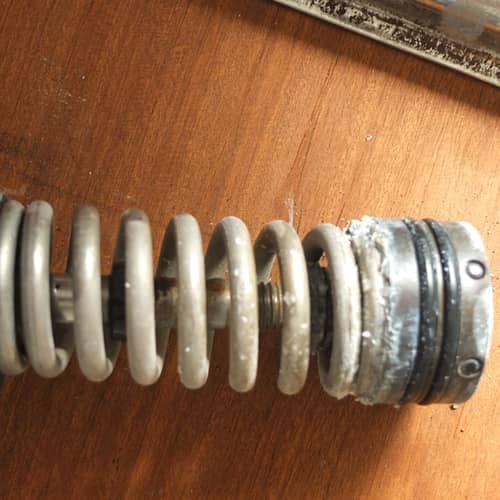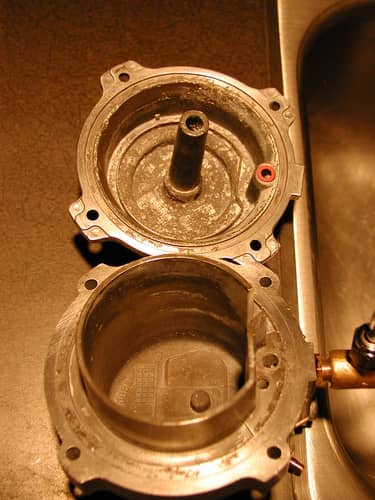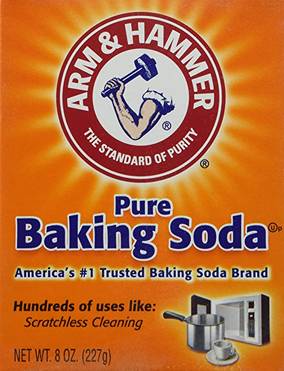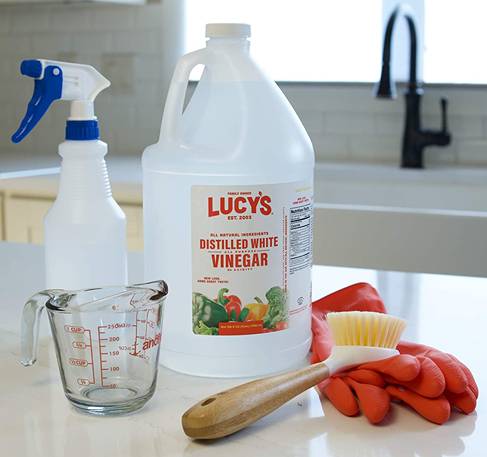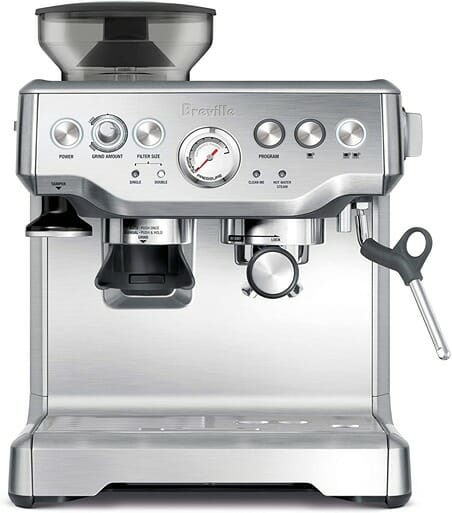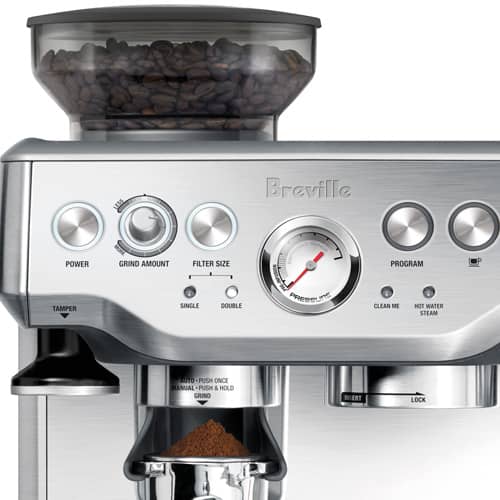Making and drinking coffee is always fun and games, especially with a quality Breville espresso machine, until you have to clean up.
The longer you leave it, the harder it is to get around to the deed and the worse your coffee will taste, so better start late than never.
And, just everyday maintenance isn’t enough to keep your coffee maker up and running either. Once in a while, you need to give it a deep cleaning session AKA descaling.
In this article, I will show you how to descale a Breville espresso machine down to the last detail to prep you up for the nasty war. Sounds tough but the process is actually a lot simpler than you might imagine.
Do I Need To Descale Breville Espresso Machine?
Yes, and I cannot stress this enough, you need to descale your Breville espresso machine, just as you should with any other coffee machine.
What Is Descaling?
Descaling is a cleaning process that helps effectively remove the limescale, a white, chalky, and hard mineral deposit that builds up over time as a result of the water flowing through the coffee maker.
The harder the water in your area is, the more often you’ll have to get your Breville coffee machine descaled due to more mineral buildup.
Why Descaling Is Required?
The more this chalky deposit develops in and on the inner components of your Breville espresso machines, the more likely it’ll affect their performance. Some of the common effects are:
- Reduced water flow
- Reduced brewing temperature
- Damaged functioning components
- Cold and poorly brewed espresso with an uneven extraction
So if you don’t want to end up with a broken Breville espresso machine sooner than expected and a mediocre, if not terrible, cup of espresso, you’d better not skip the descaling process.
But, shouldn’t the regular cleaning process be enough?
What Is The Difference Between Cleaning And Descaling?
Little did you know the cleaning cycle and descaling cycle are actually 2 completely separate processes.
The cleaning cycle is mostly for removing coffee residue, like old coffee grounds and oils from coffee beans, which can lead to clogging and unfavorable taste in your Joe.
You wouldn’t want to be there when the oils go rancid.
So, you still need to descale to have a clean Breville espresso machine free of limescale.
This article will be zooming in on the descaling process, specifically. So if you’re looking for a regular cleaning guide, check out my article on how to clean a Breville espresso machine.
And aside from these 2, you need to do daily cleaning for components like the coffee grind bin as well.
How Often Should I Descale My Breville Espresso Machine?
If you’re using a Breville espresso machine, generally, you can rely on its CLEAN/DESCALE light to let you know when either is required.
Otherwise, you can descale every 2 – 3 months, depending on the water hardness in your area.
If you identify any of the effects of excess mineral buildup inside the espresso machine I listed above, that’s likely the issue, so get to descaling right away to see whether the issue goes away.
Can I Use My Breville Espresso Machine Without A Filter?
Yes, regular tap water should work, as long as it doesn’t have any weird taste that may transfer to the coffee.
But, the machine would be more high-maintenance then, especially when using hard water. If you don’t mind cleaning often, be my guest.
Do I Need To Descale If I Use Filtered Water?
Using water that’s been filtered/purified, like spring water, can decrease the need to descale and improve the taste of your espresso.
So, since there’s still mineral build-up, just slower over time, you’d still need to descale the espresso machine.
However, though hard water isn’t good, completely (or nearly completely) demineralized or distilled freshwater isn’t the best idea either as it can potentially damage the coffee machines and alter the coffee’s taste, as addressed by Breville.
You can also opt for inserting a water filter, which is also supplied by Breville. The brand details that you need to change the water filter and wash the filter holder every 2 months, which can help reduce the need for descaling.
And if you’re using very hard water, change it more often. You can also find instructions for replacing the new filter in my previous article.
Keep in mind that even if you’re using filtered or bottle water and a water filter on top of that, you’ll still have to replace the thingy at some point (and descale).
What Can I Use To Descale My Breville?
We like this eco-friendly brand powder or this liquid solution, both of which descale quite well. Fill it in the water tank to have it dissolve and start the descaling routine.
But, if you don’t want to spend the extra money and would rather use things that are already available at home, that’s understandable, too.
So let’s see our top alternative descaling solution candidates.
But, when it comes to the inside of your coffee maker, however, you should think twice before accidentally adding something that does more harm than good.
Can I Use Baking Soda To Clean Breville Espresso Machine?
You might have gone to your good ol’ baking soda for most if not all cleaning quests around the house. From effectively removing stains to tackling odor problems, baking soda’s got your back thanks to its mildly abrasive quality. But, for descaling a Breville machine, I wouldn’t do it if I were you.
Baking soda isn’t very water-soluble, so as you run the mixture through the device, you’re running the risk of clogging or wrecking it. It’s not the best at removing limescale either.
So, let’s settle that it isn’t the brightest idea, especially if you’re paying hundreds of bucks for a Breville machine.
But, if you want to test it out for its low cost and odor removability regardless, make sure the baking soda has completely dissolved and do it on your much cheaper coffee makers.
The silver lining is you can use baking soda to clean other parts of the machine, like the exterior or the carafe and other removable components, which might be stained with coffee.
Can I Use Vinegar To Descale My Breville Espresso Machine?
Yes, a vinegar mixture with its acidic quality makes a good descaler!
Like baking soda, it’s affordable; it’s available; but, most of all, it’s actually usable!
Is Descaling Solution Better Than Vinegar?
However, I still recommend using the designated descaling solution over the white vinegar solution.
The latter has a very powerful odor that might still remain even after you’ve run a couple of rinse cycles, while the descaling solutions are often odorless.
It isn’t as powerful, either, so it might not be able to effectively remove the limescale in age-old machines that aren’t cleaned and descaled very often.
What’s more, the smell of white vinegar water might catch on to the buildups. And you’re stuck with some not very pleasant espresso both in taste and smell.
But overall, it works well as an alternative when you don’t have the real thing lying around.
How Much Vinegar Do You Need To Descale A Breville?
I recommend using a mixture of vinegar and water following the 1:1 ratio.
How Do I Descale My Breville Espresso Machine?
The following instructions are for the Breville Barista Express, one of the best Breville espresso machines on the market in my opinion.
Before descaling, make sure to:
- Run a cleaning cycle (with cleaning tablets);
- Remove the water filter from the water reservoir;
- Empty the drip pan;
- Turn the machine off and let it completely cool down before descaling.
Step 1: Add Descaling Solution
If you’re using Breville Descaling powder, mix one sachet with 34 oz (1005.5 ml) of water until it dissolves, and pour the mixture into the water tank of the Barista Express.
If you’re using the eco-friendly descaling powder or solution I recommended above, add a packet or a bottle into the water tank and fill the rest of the tank with water.
If you’re using vinegar, use 1 cup of vinegar for every cup of water to fill the water tank.
Some models such as the Breville Barista Pro and Bambino Plus may have a DESCALE line on the reservoir to indicate until which point you should fill the descaling agent.
Step 2: Enter The Descale Mode
On the Breville Barista Express, press and hold the 2-CUP button and the POWER button at the same time to enter the Descale mode.
While the coffee machine is heating prepare for the descaling cycle, the POWER button should flash continuously.
And the illumination of these 4 buttons – POWER, 1 CUP, CLEAN/DESCALE, and HOT WATER/STEAM – should indicate that the heating process has wrapped up.
Depending on the machine, the process to get to the Descale mode may differ. Refer to the dedicated manuals of other Breville espresso machines for more information.
Step 3: Run The Descale Cycle
Place a large container (68 oz/2 l)under the portafilter and steam wand to begin with.
Press the 1 CUP button to start descaling the coffee component, which should finish in as quick as 25 seconds.
Next, you need to descale the steam and hot water components. Manually turn the Steam Dial to the right for the former and to the left for the latter. This is usually indicated on the LCD screen to help you navigate.
Each process should take roughly 13 and 8 seconds respectively. The descaling duration may differ for different Breville espresso machines.
Step 4: Repeat
By now, you should have half of the descaling solution left in the water reservoir. To finish descaling, repeat step 3.
Step 5: And Rinse
Remove, empty, and rinse the water reservoir and the large container carrying wastewater thoroughly under warm water before refilling it again with cold water to the maximum capacity to run a few cycles of rinse (Repeat step 3).
Remember to remove and empty the drip tray as well before returning it to place.
This should get rid of the descaling solution inside the machine. Run more if you find it necessary, especially when using vinegar solution.
Once you’re done, press the POWER button to exit the Descale mode, which should turn off the LED lights.
Step 6: Clean Up
Finally, remove and rinse the tank, the drip tray, and the container with plain water and let them dry completely before reattaching the first 2 back to the Barista Express machine.
Some Breville models like the Breville Barista Touch or Oracle Touch should have instructions on the screen to direct you on what to do, so just follow that and you should be fine.
See my video here on how I clean a Breville Espresso Machine:
How To Clean Other Parts Of The Breville Coffee Machine
Since you’re doing a deep cleansing session for the brewer, make sure to look after other components while you’re at it.
The following instructions are also demonstrated on the Breville Barista Express.
- Steam Wand
Each time you use the steam wand, make sure to use a damp cloth to wipe it afterward.
Then hover the steam wand tip over the drip tray and dial the STEAM/HOT WATER to the STEAM position briefly to get rid of any leftover milk.
If any hole in the steam wand is blocked, turn the espresso machine off and let it cool down before using the pin of the cleaning tool to poke out the blockage.
If that doesn’t work, use the integrated spanner of the cleaning tool to remove the top of the steam wand and soak it in hot water. Then pull out the pin again.
- Filter Baskets & Portafilter
After you brew coffee, make sure to immediately dump the used coffee grounds and rinse the filter basket(s) and portafilter under hot water to remove the oils from the coffee beans.
Again, if any hole on the filter basket is blocked, the pin is your best friend. Otherwise, grab a cleaning tablet and dissolve it in hot water to soak the filter basket and portafilter. After around 20 minutes, rinse everything with warm water.
- Shower Screen
Use a damp cloth to wipe the group head and the shower screen to get rid of any lost coffee grounds still stuck around. You can also run a quick empty brew (basically brew plain water) to purge the machine once in a while.
- Drip & Storage Tray
Good machine cleaning includes emptying and cleaning the drip tray often, especially when the machine alerts EMPTY ME! You can use a soft non-abrasive cloth and warm soapy water to get the job done.
For the storage tray which is behind the drip tray, just a simple wipe using a damp cloth should suffice.
- Outer Housing
Again, use a soft damp cloth to wipe down the machine to keep it clean and shining.
FAQs
How Do You Reset The Descale Light On A Breville Espresso Machine?
If you’ve finished the descaling cycle accordingly, yet, the light is still on, try contacting Breville Customer Support or this helpful tip from a fellow user:
Turn the machine off and press and hold the 2 CUP and POWER buttons simultaneously for around 5 seconds until the latter lights up. Then turn off the power and (you can wait for a bit) on again and the Descale light should disappear.
Why Does My Coffee Taste Bad After Descaling?
If your perfect coffee still doesn’t return after descaling, it’s possible that:
- You still have some age-old stubborn limescale left
- Some descaling agent still resides
Try running a couple more rinsing cycles with just hot water to make sure you’ve flushed them all out.


